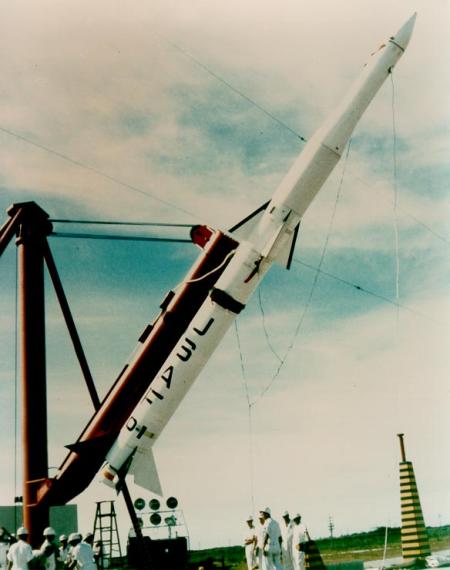Ford RM-91 Blue Scout Junior
The XRM-91 Blue Scout Junior (sometimes called Journeyman B) was a rocket of the U.S. Air Force's System 609A Blue Scout family (for general information on Blue Scout, see article on RM-89 Blue Scout I). The XRM-91 did not resemble the other Scout variants externally, because the usual first Scout stage (an Aerojet General Algol) was not used. Instead, the four-stage Blue Scout Junior used Scout's 2nd and 3rd stages (Castor and Antares) as the first two stages, and added an Aerojet General Alcor and a spherical NOTS Cetus in a common nose fairing. The XRM-91 also lacked the gyro-stabilization and guidance system of the RM-89 Blue Scout I and RM-90 Blue Scout II, making it a completely unguided rocket. It relied on second-stage fins and two spin motors to achieve a stable flight trajectory.
 |
| Photo: USAF |
| XRM-91 |
The first launch of an XRM-91 occurred on 21 September 1960, making it actually the first Blue Scout configuration to fly. The flight was planned to make radiation and magnetic field measurements at distances of up to 26700 km (16600 miles) from earth, and while the rocket did indeed achieve this altitude, the telemetry system failed so that no data was received. The second launch in November ended with a failure during second stage burn. The third flight was to measure particle densities in the Van Allen belts and reached a distance of 225000 km (140000 miles), but again a telemetry failure prevented the reception of scientific data. The fourth and final XRM-91 mission in December 1961 also carried particle detectors, and was the only completely successful flight of the initial Blue Scout Junior program. The Blue Scout Junior would have been easily powerful enough to put a small satellite in low-earth orbit but was never used to do so.
 |
| Photo: USAF |
| XRM-91 |
The Blue Scout Junior was regarded by the USAF as the most useful of the various Blue Scout configurations. It was used between between 1962 and 1965 by the Air Force to launch suborbital scientific payloads to very high altitudes. The SLV-1B* was effectively identical to the XRM-91, and was launched seven times between July 1963 and June 1965 with magnetospheric experiments as payload. The LV-1B (also known as SLV-1B(m)) was a three-stage variant which omitted the Cetus 4th stage of XRM-91/SLV-1B. The USAF lauchned three LV-1Bs between November 1962 and December 1964 on ion engine test missions. The SLV-1C was another three stage rocket, which replaced the LV-1B's Alcor third stage by an Altair. It was used as the rocket for the MER-6A interim ERCS (Emergency Rocket Communications System) vehicle. The NASA used a three-stage Blue Scout Junior configuration (using the same stages as the LV-1B) as the RAM B.
* Note: The SLV-1A was the Air Force's orbital Scout, see RM-92.
Specifications
Note: Data given by several sources show slight variations. Figures given below may therefore be inaccurate!
Data for XRM-91:
| Length | 12.34 m (40 ft 5.8 in) |
| Finspan | 1st stage: 2.62 m (8 ft 7 in) 2nd stage: 1.64 m (5 ft 4.6 in) |
| Diameter | 0.79 m (31 in) |
| Weight | 6300 kg (14000 lb) |
| Speed | 6 km/s (20000 ft/s) |
| Altitude | 225000 km (140000 miles) |
| Range | global (low earth orbit reachable) |
| Propulsion | 1st stage: Thiokol XM33 Castor solid-fuel rocket; 259 kN (58300 lb) for 37 s 2nd stage: Alleghany Ballistics Lab (Hercules) X-254 Antares solid-fuel rocket; 60.5 kN (13600 lb) for 39 s 3rd stage: Aerojet AJ10-41 (30KS8000) Alcor solid-fuel rocket; 36 kN (8000 lb) for 30 s 4th stage: NOTS 100A Cetus solid-fuel rocket; 4.0 kN (900 lb) for 20 s |
Main Sources
[1] Peter Alway: "Rockets of the World, 2000 Supplement", Saturn Press, 2000
[2] Norman J. Bowman: "The Handbook of Rockets and Guided Missiles", Perastadion Press, 1963
[3] Mark Wade: Encyclopedia Astronautica
[4] Jonathan McDowell: Launch Vehicles Database
Back to Directory of U.S. Military Rockets and Missiles, Appendix 1
Last Updated: 9 July 2007